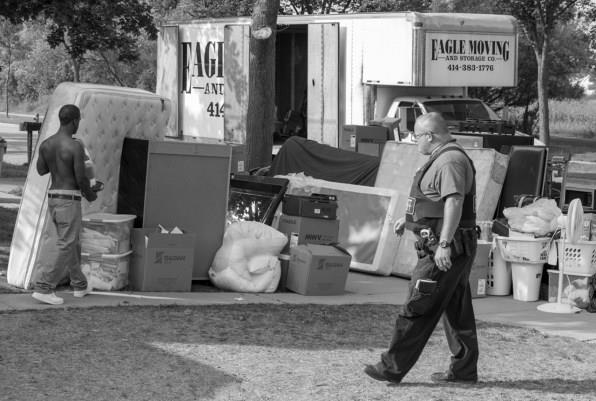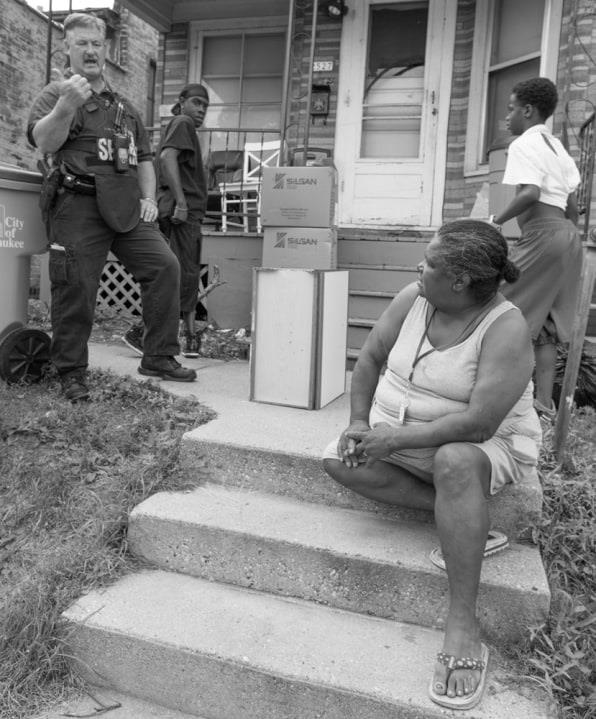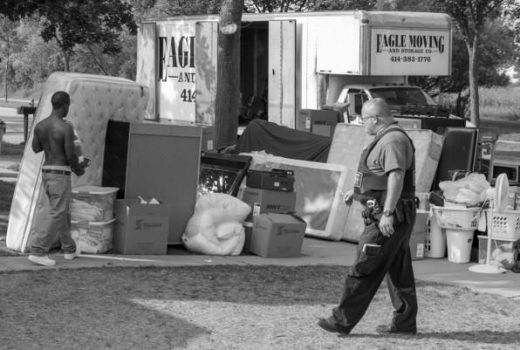This Exhibit Exposes The Stories Behind The Country’s Continuing Eviction Crisis
“For those of us that have never thought about eviction, I want them to realize what it’s doing to our families, and our children and our communities, and how it’s leaving a deep and jagged scar on the next generation.”
That’s Matthew Desmond, someone who has spend perhaps more time than anyone thinking about eviction, apart from the over 2.7 million Americans who are forced out of their homes each year. In 2016, he wrote the book Evicted: Poverty and Profit in the American City, which won the Pulitzer Prize. In it, he follows eight families and tenants in Milwaukee, a city that evicts roughly 16,000 people a year, as they move from place to place, trying to find somewhere they can stick for a while. It’s harder than it sounds. And it’s an issue that’s easier than it should be to ignore. In an interview with The Guardian last year, Desmond called eviction “a problem we need to hate more.”

If the implications and ubiquity of evictions are often hard to see in cities–sidewalks are cleared, things moved into storage–they’re much more difficult to ignore when the evidence is grouped in front of you, in one room.
Bringing visitors into direct confrontation with the magnitude of the eviction crisis is the aim of an exhibit on Desmond’s book and the issue at large, opening April 14 at the National Building Museum in Washington, D.C. (Desmond’s opening quote comes from a trailer for the exhibit). Evicted, the exhibit, both presents the stories and data from Desmond book, and expands upon it. While the book focused on Milwaukee, Desmond has since collected data on the issue into a platform called Eviction Lab, the first nationwide database on evictions, and that information, along with related photojournalism and storytelling, also permeates the exhibit.
The idea for the exhibit, says NBM curator Sarah Leavitt, “with me literally lying on the floor in my dining room, staring up at the ceiling, right after finishing the book.” She had picked up Desmond’s book on a whim, but “it threw me,” she says. She wanted to do something, “and then I remembered: Oh right, I work in a museum about the built environment, and I talk to visitors all the time about housing, and what is important about home.”
Leavitt emailed Desmond to talk with him about how they might work together to create an exhibition at NBM around the book. He called her back the same day.

The story of how the eviction crisis has evolved and intensified in recent years forms the backbone of the exhibit. Thirty years ago, they were somewhat rare. Single black women with children were hardest hit. But in the intervening decades, wages for much of the lower and middle class have stagnated, while housing costs have skyrocketed. Around 70% of families who qualify for federal housing assistance now do not receive it. And they’re the ones now who are left to cope with chronic eviction and displacement.
While he was reporting Evicted in Milwaukee, Desmond met many families like these, and several photographers came with him to capture their lives as they were uprooted. Though his publisher ultimately convinced him not to use the photographs in the book (as it would raise the price), they found a home in the NBM exhibit.
Those photographs are paired others taken specifically for the exhibit, which follow other families (not those Desmond interviewed) through the whole process of eviction, from walking out their door for the last time to the courthouse, to the long housing search, and back through it again. An audio production team that Desmond was working with to produce a radio documentary on eviction captured interviews with those families, whom they met through visiting various eviction and housing courts across the country. Their stories narrate the photographs. Large-scale infographics cover the walls to put the documentary material into context.
Ultimately, Leavitt wants the exhibit to catalyze action. Before they walk out, visitors encounter a display of the various ways that states and cities are working to combat chronic eviction, through passing Right to Counsel laws for tenants, which cities like New York and D.C. are piloting, and financing permanently affordable housing models like community land trusts and cooperatives. “We want to show that this isn’t an inevitable crisis, or something we just have to deal with,” Leavitt says. “This is something that we have to fight.”
(37)


